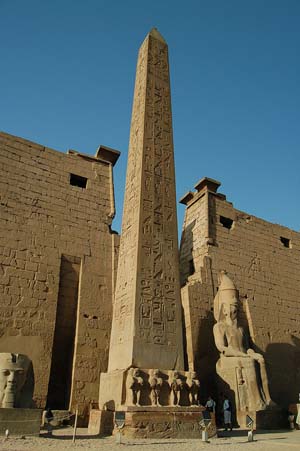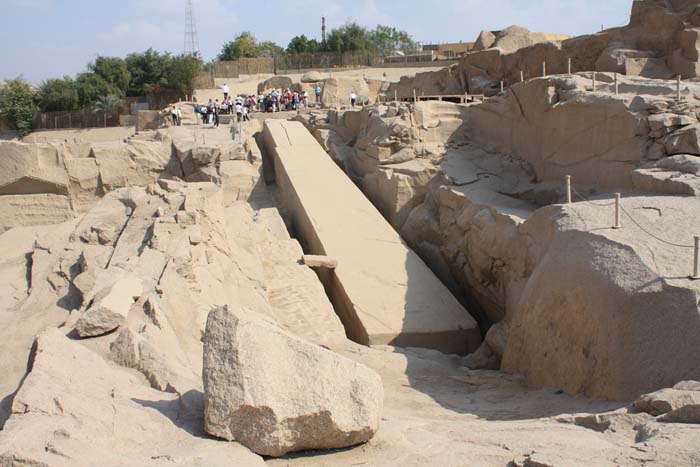Ancient Egyptian Obelisks
The ancient Egyptians knew them as tekhenu; today, they are known as obelisks and first appeared in historical records around 2575 BC. By definition, an obelisk is a tall, narrow monument with four sides that taper into a pyramid at the top.
Obelisks were generally constructed of red granite or similar stone and according to a specific formula that would generate a monument of maximum height for a minimum-sized base. Although the earliest obelisks were a little over 3 meters tall, or about 10 feet, they gradually became taller, reaching about 30 meters, or around 100 feet, in height.

© ohhenry415 - Obelisk
Egyptian obelisks were monolithic, which means they were hewn from a single stone, and then moved to their intended destination; other cultures frequently did not utilize the monolithic construction method so transportation was less of a problem. Although current technology is able to move similar-sized megaliths, it is unable to erect them to an upright position by using technologies that were known to the ancient Egyptians.
The stone for Egyptian monoliths was quarried by use of dolerite balls; dolerite is volcanic rock and thus is harder than granite. The dolerite balls were dropped into small hand-hewn fissures. These fissures were enlarged by dropping wood into them and then soaking the wood with water. The water-soaked wood forced the fissures apart, enabling the workers to gradually hew the obelisk from a massive piece of stone.
Obelisks were used at entrances to temples of the sun god and were covered in an alloy called electrum, which is comprised of four parts gold to one part silver. Hieroglyphic dedications and commemorations embellished the alloy and the morning sun would transform the obelisks into beacons of illumination and homage to the sun god. Ancient Egyptians ascribed their obelisks with magical powers of protection due to their proximity to the temples.
History of Obelisks in Ancient Egypt
The ancient Egyptians were prolific in their use of obelisks, which were erected to honor major events such as a coronation, a major victory, or other such event, as well as to honor their sun god. This inspired other cultures to emulate the Egyptians and erect similar monuments. The Greeks, Romans, Assyrians and many other cultures began to use obelisks to honor and elevate their deities and royalty.
The Obelisk of Senusret I, who ruled from 1971 to 1926 BC, is one of the oldest surviving Egyptian temple obelisks still at the original location. Located in Heliopolis, it was a symbol of the sun god Ra and he was thought to inhabit the monolith. Some scientists hypothesize that this obelisk was connected to the astronomical phenomena associated with the zodiacal light of sunrise and sunset.
The tallest known Egyptian obelisk, the Unfinished Obelisk, was abandoned when it was about 75 percent completed due to cracks that appeared in it. At completion, the monolith would have been have been about 120 feet tall and would have weighed in excess of 1150 tons; it is thought to have been the companion of the Lateran Obelisk at Karnak.

© Michael Lusk - The Unfinished Obelisk
Symbolism of Obelisks in Ancient Egypt
Ancient pharaohs were considered to be divine rulers and intercessors between the gods and the people. Therefore, the pharaohs were the ones who ordered construction of the obelisks, which were symbolic of the pharaohs’ divinity as well as objects of worship of the Egyptian sun god Ra. The hieroglyphic inscriptions recorded the deeds and accomplishments of the pharaoh. The construction of the obelisk ensured that the top of the obelisk would capture the rays of both the rising and the setting sun, thereby honoring Ra.

© Ian Scott - Obelisk Hieroglyphs
Famous Obelisks in Ancient Egypt
Two famous ancient Egyptian obelisks that were built by Thutmose III were relocated first to Cleopatra’s palace and subsequently, one to Central Park in New York and the other to England on the bank of the Thames River.
Emperor Augustus moved one of Egypt’s ancient obelisks to Alexandria and it ultimately arrived at Saint Peter’s Square in Vatican City; this is the only monolith in Rome that has not fallen since the time of the Romans. Another, originally at the Luxor Temple, was moved to the Place de la Concorde in France.
The Lateran Obelisk, the tallest one in the world, is now located in Rome, Italy. The Heliopolis Obelisk remains in Cairo, Egypt and is the oldest Egyptian obelisk that remains erect.

© upyernoz - Obelisk of Thutmose III (originally located at Karnak), at the Hippodrome of Constantinople (Istanbul)
Facts About Obelisks in Ancient Egypt
- The ancient Egyptian obelisks were constructed by simple technologies that rival the most sophisticated technologies available today. They were raised upright without machines in a manner that cannot be duplicated today.
- Egyptians built more obelisks than any other society. Although many were destroyed due to war, invasion, and other calamities, many remain standing to this day, a testament to the engineering prowess of the ancient Egyptians.
- Egyptians sometimes exported an obelisk to another country in order to pay off a debt.
- Only one woman, Queen Hatshepsut, who began her 22-year rule around 1478 BC, built some of the Egyptian obelisks; all other obelisks were built by men.
- Transporting an ancient Egyptian obelisk from its construction site to its intended destination generally took about seven months, an impressive feat considering the size of the monolith and the relatively primitive technology that existed at the time.
- When the sun is directly overhead, an obelisk casts no shadow.
